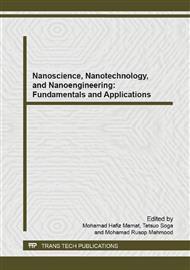[1]
N. H. Noor Haslinda, F. Abas, K. Shaari, N. H. Lajis, LC–DAD–ESIMS/MS characterization of antioxidant and anticholinesterase constituents present in the active fraction from Persicaria hydropiper, Food Science and Technology. 46 (2012) 468–476.
DOI: 10.1016/j.lwt.2011.11.021
Google Scholar
[2]
B. Bunawan, C. Y. Choong, M. Z. Badrul Munir, B. Syarul Nataqin, M. N. Normah, Molecular Systematics of Polygonum minus Huds. Based on ITS Sequences, International journal of molecular sciences. 12 (2011) 7626–7634.
DOI: 10.3390/ijms12117626
Google Scholar
[3]
A. Faridah, H. L. Nordin, D. A. Israf, S. Khozirah, Y. Umi Kalsom, Antioxidant and nitric oxide inhibition activities of selected Malay traditional vegetables, Food Chemistry. 95 (2006) 566-573.
DOI: 10.1016/j.foodchem.2005.01.034
Google Scholar
[4]
S. W. Qader, M. A. Abdulla, L. S. Chua, N. Najim, M. M. Zain, S. Hamdan, Antioxidant, total phenolic content and cytotoxicity evaluation of selected Malaysian plants, Molecules. 16 (2011) 3433–3443.
DOI: 10.3390/molecules16043433
Google Scholar
[5]
S.Vimala, M. A. Ilham, A. A. Rashih, S. Rohana, Nature's Choice to Wellness: Antioxidant Vegetable/Ulam, Siri Alam dan Rimba 7, Forest Research Institute Malaysia (FRIM), Malaysia, 2003.
Google Scholar
[6]
A. Nurain, A. Noriham, M. N. Zainon, Z. Khairusy Syakirah, W. K. Wan Saifatul Syida, Phytochemical constituents and in vitro bioactivity of ethanolic aromatic herb extracts, Sains Malaysiana. 41 (2012)1437–1444.
Google Scholar
[7]
S. W. Qader, M. A. Abdulla, L. S. Chua, H. Salehhuddin, Potential bioactive property of Polygonum minus Huds (kesum) review, Scientific Research and Essays. 7 (2012) 90–93.
Google Scholar
[8]
S. Vimala, S. Rohana, A. A. Rashih, M. Juliza, Antioxidant evaluation in Malaysian medical plant: Persicaria minor (Huds.) Leaf, Science Journal of Medicine & Clinical Trials. (2012) 9-16.
Google Scholar
[9]
M. Maizura, A. Aminah, W. M. Wan Aida, Total phenolic content and antioxidant activity of kesum (Polygonum minus), ginger (Zingiber officinale) and turmeric (Curcuma longa) extract, International Food Research Journal. 18(2011) 529–534.
DOI: 10.21448/ijsm.993906
Google Scholar
[10]
S. Vimala, A. Mohd Ilham, Malaysian tropical forest medicinal plants: A source of natural antioxidants, Journal of Tropical Forest Products. 5(1999) 32-38.
Google Scholar
[11]
A. Hidayah, A. Noriham, M. Rusop, The potential of Nanotechnology application in improving bioactivity of Malaysian plants, in Zainal, et al. (Eds.), Current issues in hospitality and tourism research and innovations, Taylor & Francis Group : London, 2012, pp.25-255.
DOI: 10.1201/b12752-49
Google Scholar
[12]
P. Y. Ma, Z. Y. Fu, Y. L. Su, J. Y. Zhang, W. M. Wang, H. Wang, Modification of physicochemical and medicinal characterization of Liuwei Dihuang particles by ultrafine grinding, Powder Technology. 191 (2009) 194-199.
DOI: 10.1016/j.powtec.2008.10.008
Google Scholar
[13]
T. Takatsuka, T. Endo, Y. Jianguo, K. Yuminoki, N. Hashimoto, Nanosizing of poorly water soluble compounds using rotation/revolution mixer, Chem. Pharm. Bull. 57 (2009)1061-1067.
DOI: 10.1248/cpb.57.1061
Google Scholar
[14]
R. Sonada, M. Horibe, T. Oshima, T. Iwasaki, S. Watano, Improvement of dissolution Property of poorly water- soluble drug by novel dry coating method using planetary ball mill, Chem. Pharm. Bull. 56 (2008) 1243-1247.
DOI: 10.1248/cpb.56.1243
Google Scholar
[15]
V. J. Mohanraj, Y. Chen, Nanoparticles – A review, Tropical Journal of Pharmaceutical Research. 5 (2006) 561-573.
Google Scholar
[16]
S. S. Bhadoriya, A. Mangal, N. Madoriya, P. Dixit, Bioavailability and bioactivity enhancement of herbal drugs by "Nanotechnology" : A review, Journal of Current Pharmaceutical Research. 8 (2011) 1-7.
Google Scholar
[17]
M. Cushen, J. Kerryb, M. Morrisc, M. Cruz-Romerob, E. Cummins, Nanotechnologies in the food industry – Recent developments, risks and regulation, Trends in Food Science & Technolog. 24 (2012) 30-46.
DOI: 10.1016/j.tifs.2011.10.006
Google Scholar
[18]
H. D. Chen, J. C. Weiss, F. Shahidi, Nanotechnology in nutraceuticals and functional foods. Food Technology, 25 (2006) 30-36.
Google Scholar
[19]
J. Kim, D. H. Jung, H. Rhee, S.-H. Choi, M. J. Sung, W. S. Choi, Improvement of bioavailability of water insoluble drugs: estimation of intrinsic bioavailability, Korean J. Chem. Eng. 25 (2008) 171-175.
DOI: 10.1007/s11814-008-0031-4
Google Scholar
[20]
Y. I. Su, Z. Y. Fu, C. J. Quan, W. M. Wang, Fabrication of nano Rhizama Chuanxiong particles and determination of tetramethylpyrazine, Transactions of Nonferrous Metals Society of China. 16 (2006), s393-s397.
DOI: 10.1016/s1003-6326(06)60218-5
Google Scholar
[21]
K. Itoh, A. Pongpeerapat, Y. Tozuka, T. Oguchi, K. Yamamoto, Nanoparticle formation of poorly water-soluble drugs from ternary ground mixtures with PVP and SDS, Chem. Pharm. Bull. 51 (2003) 171-174.
DOI: 10.1248/cpb.51.171
Google Scholar
[22]
A. Charkhi, H. Kazemian, M. Kazemeini, Optimized experimental design for natural clinoptilolite zeolite ball milling to produce nano powders, Powder Technology. 203 (2010) 389–396.
DOI: 10.1016/j.powtec.2010.05.034
Google Scholar
[23]
Y. Zhang, Y.Yang, K. Tang, X. Hu, G. Zou, Physicochemical characterization and antioxidant activity of Quercetin-loaded Chitosan nanoparticles, Journal of Applied Polymer Science. 107 (2008) 891-897.
DOI: 10.1002/app.26402
Google Scholar
[24]
M. Z. Borhan, R. Ahmad, M. Rusop, S. Abdullah, Optimization of ball milling parameters to produce Centella asiatica herbal nanopowder, Journal of Nanostructure in Chemistry. 3 (2013) 79.
DOI: 10.1186/2193-8865-3-79
Google Scholar
[25]
R. Rajkhowa, L. Wang, J. Kanwar, X.Wang, Fabrication of ultrafine powder from eri silk through attritor and jet milling, Powder Technology. 191 (2009)155–163.
DOI: 10.1016/j.powtec.2008.10.004
Google Scholar
[26]
J. Lee, Drug nano- and microparticles processed into solid dosage forms: physical properties, J. Pharm. Sci. 92(2003) 2057–2068.
DOI: 10.1002/jps.10471
Google Scholar
[27]
K. Khairudin, N. A. Sukiran, H. H. Gog, S. N. Baharum, N. M. Noor, Direct discrimination of different plant populations and study on temperature effects by Fourier transform infrared spectroscopy, Metabolomic. (2013) s11306.
DOI: 10.1007/s11306-013-0570-5
Google Scholar
[28]
D. L. Pavia, G. M. Lampman, G. S. Kriz, Introduction to spectroscopy (3rd ed.) USA: Thompson Learning, (2001).
Google Scholar
[29]
A. Suresh, T. Yasuhiro, S. Seikichi, T. Kazuhiko, K. Shigetoshi, Secoorthosiphols A-C: three highly oxygenated secoisopimarane-type diterpenes from Orthosiphon stamineus. Letters, 43 (2002) 1473-1475.
DOI: 10.1016/s0040-4039(02)00037-0
Google Scholar


